Abstract
1. The interaction between endogenous nitric oxide (NO) and factors from the rat submandibular salivary gland such as epidermal growth factor (EGF) on gastric mucosal integrity in the rat has been investigated. 2. Bolus administration of the NO synthase inhibitor, NG nitro-L-arginine methyl ester (L-NAME; 6.25-50 mg kg-1, i.v.) to animals treated intraluminally with 0.15 N HCl resulted in a significant increase in the area of mucosal haemorrhagic damage at doses 12.5 and 50 mg kg-1. Concurrent administration of indomethacin (5 mg kg-1, i.v.) resulted in a significant haemorrhagic mucosal damage in response to L-NAME (12.5-50 mg kg-1). Administration of the highest dose of L-NAME resulted in an increase in histological damage to the rat gastric mucosa. 3. When compared to control animals, the extent of damage produced by L-NAME or L-NAME in combination with indomethacin was significantly exacerbated in rats which had been sialoadenectomized (SALX) by removal of the submandibular salivary glands. The mucosal damage in SALX rats was ameliorated by treatment with EGF (5 and 10 micrograms kg-1, i.v.). 4. L-NAME administration resulted in a small reduction of gastric mucosal blood flow as assessed by laser Doppler flowmetry (LDF). The reduction in LDF by 25 and 50 mg kg-1 L-NAME was significantly greater in SALX rats than in rats with intact salivary glands. Pretreatment of SALX rats with indomethacin did not augment this large decrease in LDF suggesting that endogenous prostanoids do not interact with NO and salivary factors in regulating mucosal microcirculation.(ABSTRACT TRUNCATED AT 250 WORDS)
Full text
PDF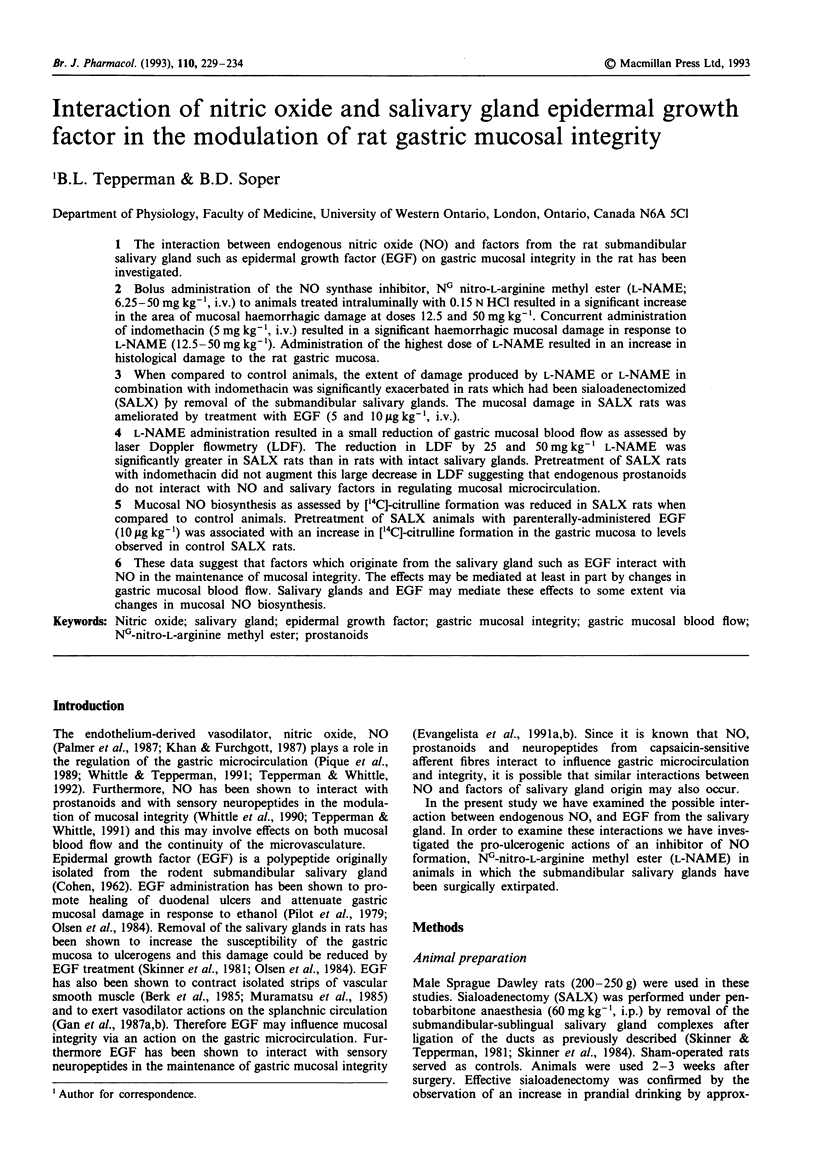
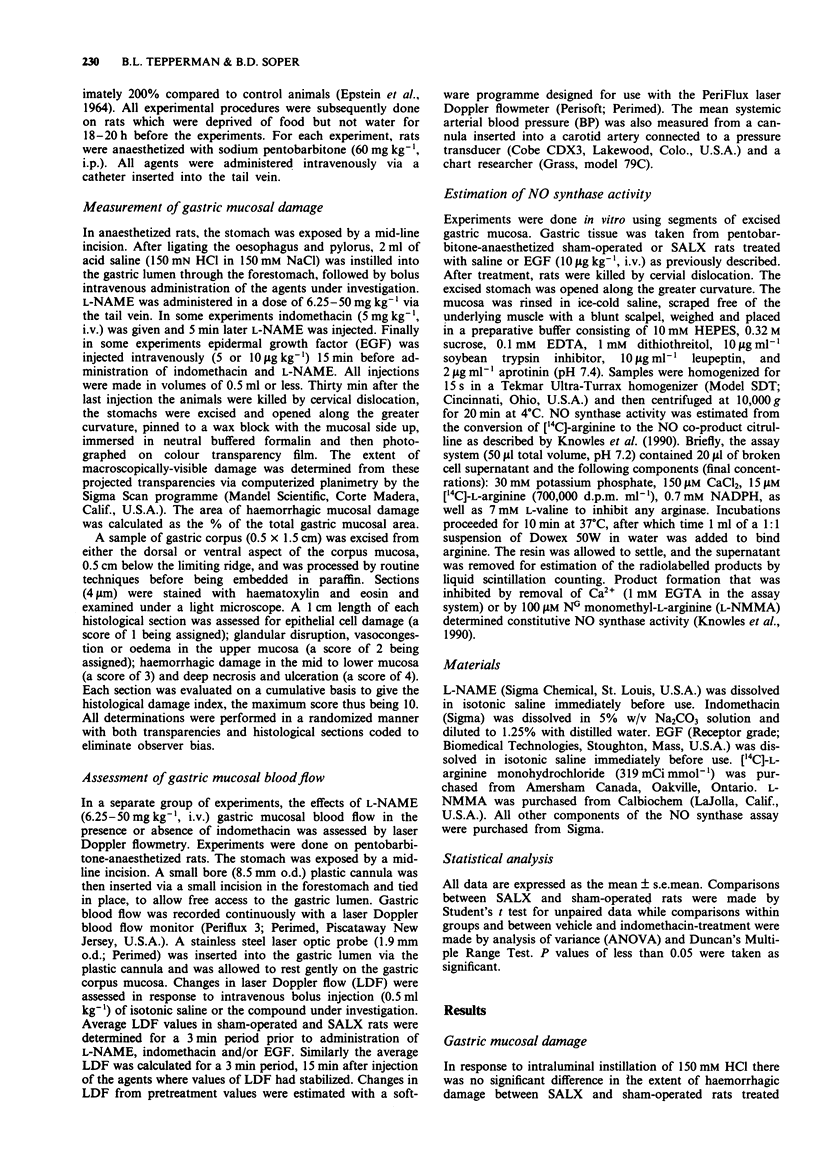
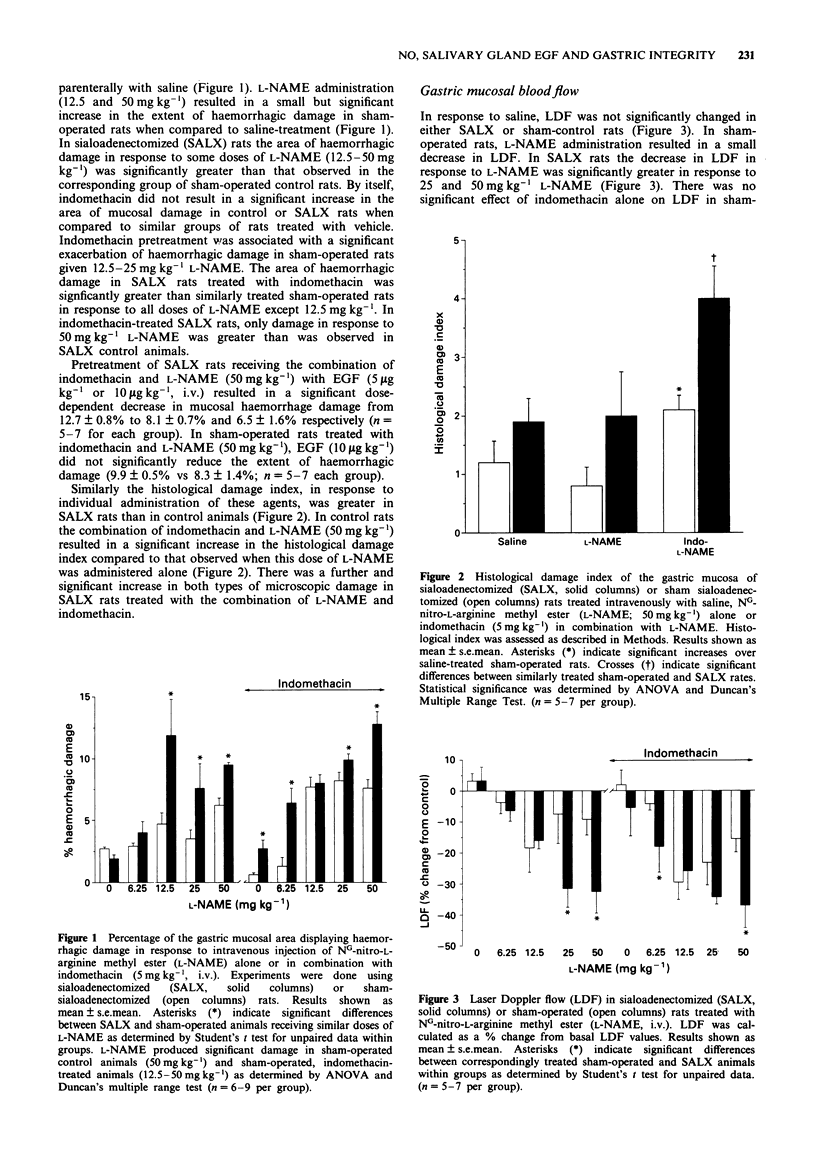
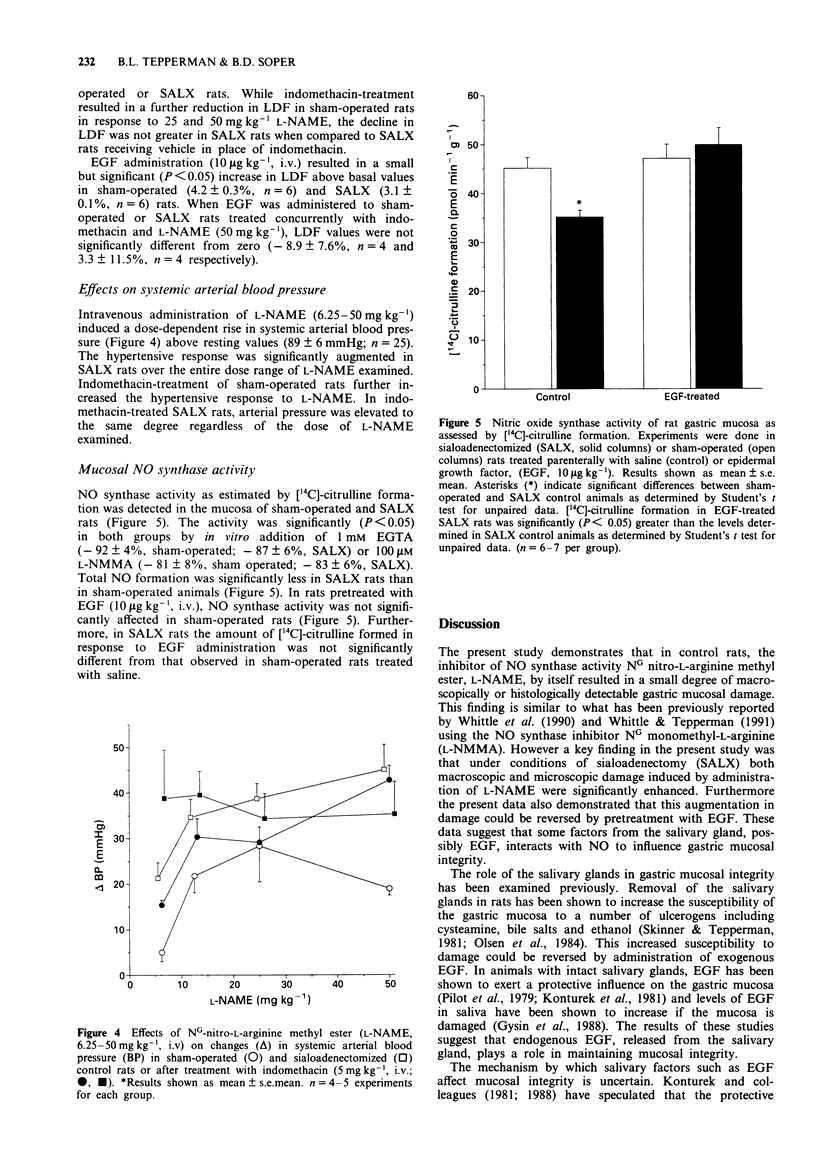
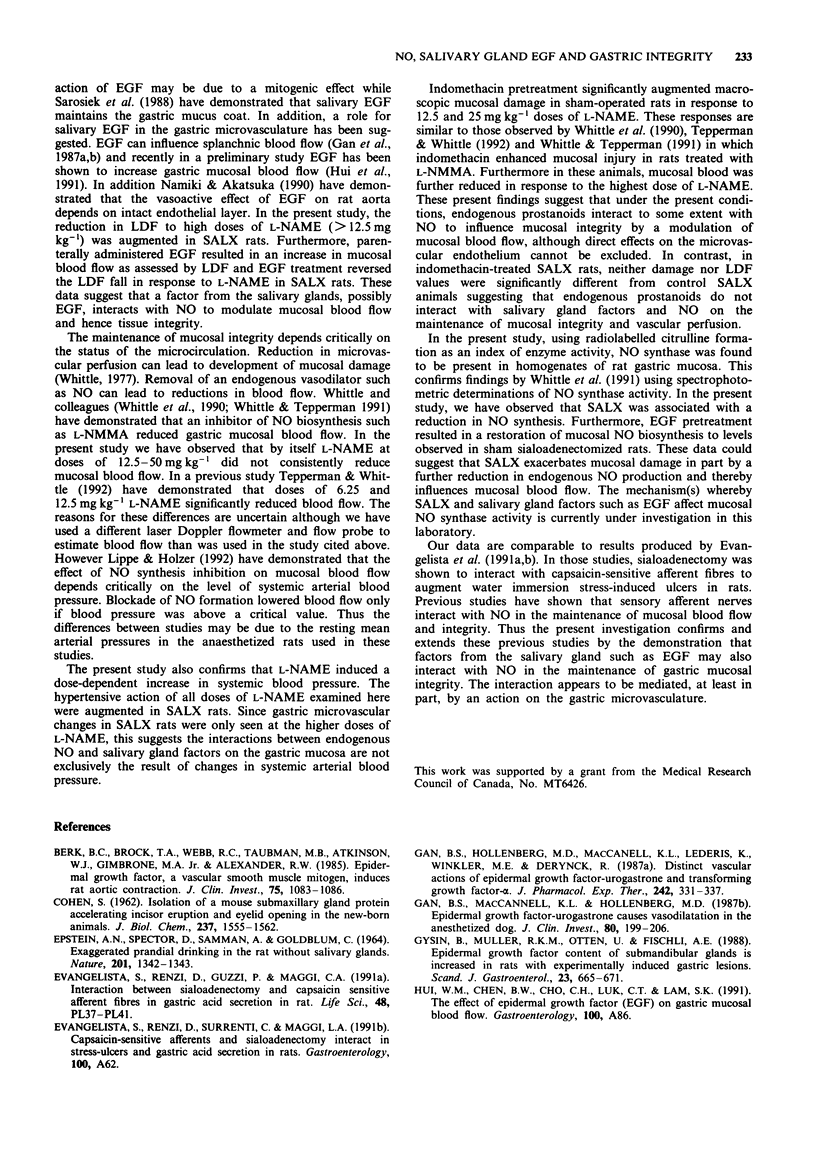
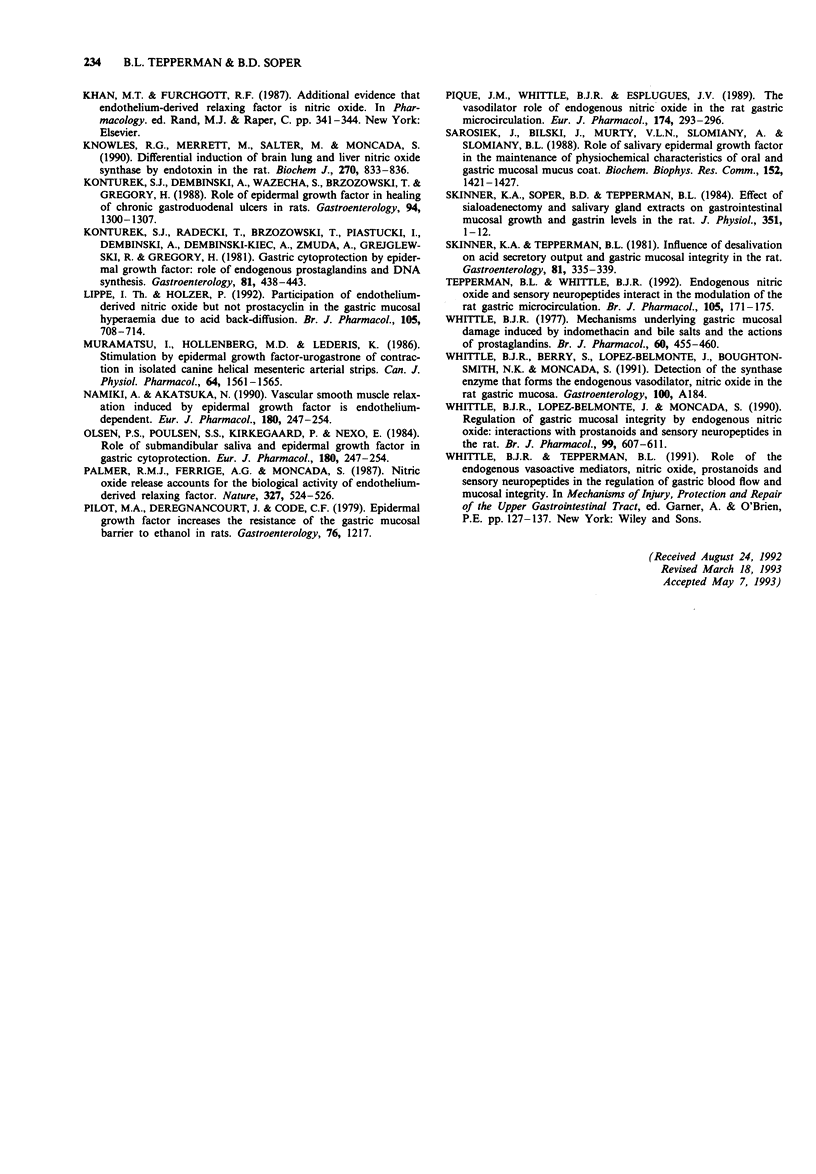
Selected References
These references are in PubMed. This may not be the complete list of references from this article.
- Berk B. C., Brock T. A., Webb R. C., Taubman M. B., Atkinson W. J., Gimbrone M. A., Jr, Alexander R. W. Epidermal growth factor, a vascular smooth muscle mitogen, induces rat aortic contraction. J Clin Invest. 1985 Mar;75(3):1083–1086. doi: 10.1172/JCI111772. [DOI] [PMC free article] [PubMed] [Google Scholar]
- COHEN S. Isolation of a mouse submaxillary gland protein accelerating incisor eruption and eyelid opening in the new-born animal. J Biol Chem. 1962 May;237:1555–1562. [PubMed] [Google Scholar]
- EPSTEIN A. N., SPECTOR D., SAMMAN A., GOLDBLUM C. EXAGGERATED PRANDIAL DRINKING IN THE RAT WITHOUT SALIVARY GLANDS. Nature. 1964 Mar 28;201:1342–1343. doi: 10.1038/2011342a0. [DOI] [PubMed] [Google Scholar]
- Evangelista S., Renzi D., Guzzi P., Maggi C. A. Interactions between sialoadenectomy and capsaicin-sensitive afferent fibers on gastric acid secretion in rats. Life Sci. 1991;48(7):PL37–PL41. doi: 10.1016/0024-3205(91)90549-q. [DOI] [PubMed] [Google Scholar]
- Gan B. S., Hollenberg M. D., MacCannell K. L., Lederis K., Winkler M. E., Derynck R. Distinct vascular actions of epidermal growth factor-urogastrone and transforming growth factor-alpha. J Pharmacol Exp Ther. 1987 Jul;242(1):331–337. [PubMed] [Google Scholar]
- Gan B. S., MacCannell K. L., Hollenberg M. D. Epidermal growth factor-urogastrone causes vasodilatation in the anesthetized dog. J Clin Invest. 1987 Jul;80(1):199–206. doi: 10.1172/JCI113048. [DOI] [PMC free article] [PubMed] [Google Scholar]
- Gysin B., Müller R. K., Otten U., Fischli A. E. Epidermal growth factor content of submandibular glands is increased in rats with experimentally induced gastric lesions. Scand J Gastroenterol. 1988 Aug;23(6):665–671. doi: 10.3109/00365528809093929. [DOI] [PubMed] [Google Scholar]
- Knowles R. G., Merrett M., Salter M., Moncada S. Differential induction of brain, lung and liver nitric oxide synthase by endotoxin in the rat. Biochem J. 1990 Sep 15;270(3):833–836. doi: 10.1042/bj2700833. [DOI] [PMC free article] [PubMed] [Google Scholar]
- Konturek S. J., Dembinski A., Warzecha Z., Brzozowski T., Gregory H. Role of epidermal growth factor in healing of chronic gastroduodenal ulcers in rats. Gastroenterology. 1988 Jun;94(6):1300–1307. doi: 10.1016/0016-5085(88)90667-1. [DOI] [PubMed] [Google Scholar]
- Konturek S. J., Radecki T., Brzozowski T., Piastucki I., Dembiński A., Dembińska-Kieć A., Zmuda A., Gryglewski R., Gregory H. Gastric cytoprotection by epidermal growth factor. Role of endogenous prostaglandins and DNA synthesis. Gastroenterology. 1981 Sep;81(3):438–443. [PubMed] [Google Scholar]
- Lippe I. T., Holzer P. Participation of endothelium-derived nitric oxide but not prostacyclin in the gastric mucosal hyperaemia due to acid back-diffusion. Br J Pharmacol. 1992 Mar;105(3):708–714. doi: 10.1111/j.1476-5381.1992.tb09043.x. [DOI] [PMC free article] [PubMed] [Google Scholar]
- Muramatsu I., Hollenberg M. D., Lederis K. Modulation by epidermal growth factor--urogastrone of contraction in isolated canine helical mesenteric arterial strips. Can J Physiol Pharmacol. 1986 Dec;64(12):1561–1565. doi: 10.1139/y86-262. [DOI] [PubMed] [Google Scholar]
- Namiki A., Akatsuka N. Vascular smooth muscle relaxation induced by epidermal growth factor is endothelium-dependent. Eur J Pharmacol. 1990 May 16;180(2-3):247–254. doi: 10.1016/0014-2999(90)90308-s. [DOI] [PubMed] [Google Scholar]
- Olsen R. W., Snowhill E. W., Wamsley J. K. Autoradiographic localization of low affinity GABA receptors with [3H]bicuculline methochloride. Eur J Pharmacol. 1984 Mar 23;99(2-3):247–248. doi: 10.1016/0014-2999(84)90249-8. [DOI] [PubMed] [Google Scholar]
- Palmer R. M., Ferrige A. G., Moncada S. Nitric oxide release accounts for the biological activity of endothelium-derived relaxing factor. Nature. 1987 Jun 11;327(6122):524–526. doi: 10.1038/327524a0. [DOI] [PubMed] [Google Scholar]
- Pique J. M., Whittle B. J., Esplugues J. V. The vasodilator role of endogenous nitric oxide in the rat gastric microcirculation. Eur J Pharmacol. 1989 Dec 19;174(2-3):293–296. doi: 10.1016/0014-2999(89)90324-5. [DOI] [PubMed] [Google Scholar]
- Sarosiek J., Bilski J., Murty V. L., Slomiany A., Slomiany B. L. Role of salivary epidermal growth factor in the maintenance of physicochemical characteristics of oral and gastric mucosal mucus coat. Biochem Biophys Res Commun. 1988 May 16;152(3):1421–1427. doi: 10.1016/s0006-291x(88)80444-3. [DOI] [PubMed] [Google Scholar]
- Skinner K. A., Soper B. D., Tepperman B. L. Effect of sialoadenectomy and salivary gland extracts on gastrointestinal mucosal growth and gastrin levels in the rat. J Physiol. 1984 Jun;351:1–12. doi: 10.1113/jphysiol.1984.sp015227. [DOI] [PMC free article] [PubMed] [Google Scholar]
- Skinner K. A., Tepperman B. L. Influence of desalivation on acid secretory output and gastric mucosal integrity in the rat. Gastroenterology. 1981 Aug;81(2):335–339. [PubMed] [Google Scholar]
- Tepperman B. L., Whittle B. J. Endogenous nitric oxide and sensory neuropeptides interact in the modulation of the rat gastric microcirculation. Br J Pharmacol. 1992 Jan;105(1):171–175. doi: 10.1111/j.1476-5381.1992.tb14230.x. [DOI] [PMC free article] [PubMed] [Google Scholar]
- Whittle B. J., Lopez-Belmonte J., Moncada S. Regulation of gastric mucosal integrity by endogenous nitric oxide: interactions with prostanoids and sensory neuropeptides in the rat. Br J Pharmacol. 1990 Mar;99(3):607–611. doi: 10.1111/j.1476-5381.1990.tb12977.x. [DOI] [PMC free article] [PubMed] [Google Scholar]
- Whittle B. J. Mechanisms underlying gastric mucosal damage induced by indomethacin and bile-salts, and the actions of prostaglandins. Br J Pharmacol. 1977 Jul;60(3):455–460. doi: 10.1111/j.1476-5381.1977.tb07522.x. [DOI] [PMC free article] [PubMed] [Google Scholar]


